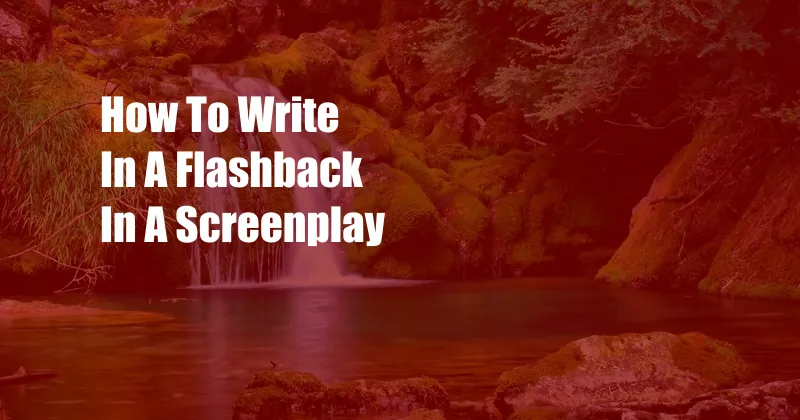
Writing Flashbacks in a Screenplay: Unveiling the Past to Enrich the Present
In the intricate tapestry of storytelling, flashbacks serve as portals through time, transporting us to moments that shape the present. As screenwriters, we possess the power to weave flashbacks seamlessly into our narratives, enriching the characters and the plot.
The Art of Flashbacks: A Narrative Triptych
Imagine yourself immersed in a gripping film, a man in his twilight years reminisces about a pivotal summer in his youth. Suddenly, the screen fades into the sun-drenched past, where he experiences love, laughter, and heartbreak. The flashback, like a suspended frame in time, provides context to his present-day choices and illuminates the intricate tapestry of his life.
In screenwriting, flashbacks shatter the constraints of linear storytelling, allowing us to explore multiple timelines and perspectives. They serve as a narrative triptych, juxtaposing present and past to deepen characterization, reveal motivations, and evoke powerful emotions.
Unveiling the Definition, History, and Power of Flashbacks
Definition: A Glimpse into the Past
A flashback is a narrative technique that transports the reader or viewer to an earlier point in time within the story. It provides additional insights into characters, events, or motivations that may not be accessible through the present-day narrative.
History: Echoes of the Past
The use of flashbacks in literature and film can be traced back centuries. From the ancient Greek epics to Shakespeare’s historical plays, flashbacks have served as a powerful storytelling tool to add depth and dimension to the narrative.
Meaning: Understanding the Past for a Richer Present
Flashbacks are not merely chronological detours; they are essential components that illuminate the present narrative. By delving into the characters’ pasts, we gain a deeper understanding of their motivations, fears, and desires. These moments of reflection add weight and significance to the present-day events, allowing us to grasp the evolution of the characters and the complexities of the plot.
A Comprehensive Guide to Writing Flashbacks
Effective flashbacks in screenwriting require careful planning and execution. Here’s a comprehensive guide to help you navigate the intricacies of flashback writing:
1. Establishing a Clear Purpose:
Identify why the flashback is necessary to the story. What crucial information or character development does it provide? Establish a clear purpose before embarking on the flashback.
2. The Journey to the Past:
Craft a distinct visual or auditory cue to signal the beginning of the flashback. This could be a fade-to-black transition, a change in lighting, or a subtle sound effect.
3. Time Stamps and Visual Signifiers:
Provide clear time stamps and visual cues to orient the audience within the flashback and distinguish it from the present-day narrative. Use changes in costumes, hairstyles, or settings to establish the different time periods.
4. Unveiling the Past, Impacting the Present:
Ensure the flashback directly influences the present-day story. It should provide crucial insights into characters or events that shape their current choices and actions.
5. Pacing and Balance:
Balance is crucial when incorporating flashbacks. They should not dominate the narrative but rather serve as complementary pieces that enhance the present-day plot.
Tips and Expert Advice from the Screenwriting Trenches
Drawing from years of experience as a screenwriter, here are some invaluable tips and expert advice:
1. Use Flashbacks Sparingly:
Like a delicate spice, flashbacks should be used sparingly. Overuse can disrupt the narrative flow and detract from the impact of each individual flashback.
2. Seek Emotional Resonance:
Flas